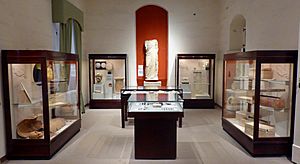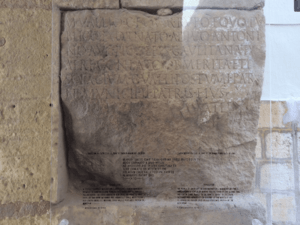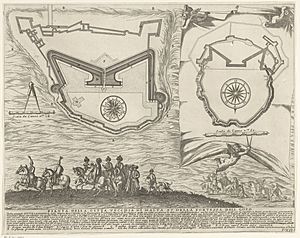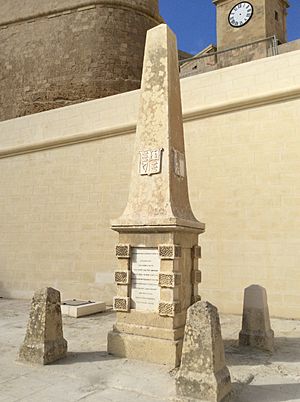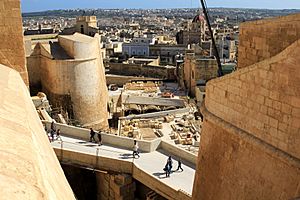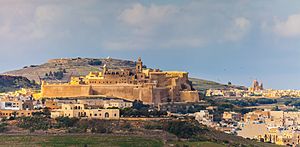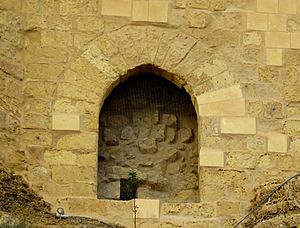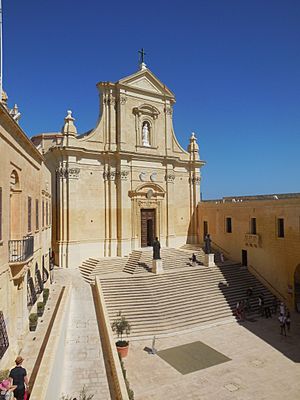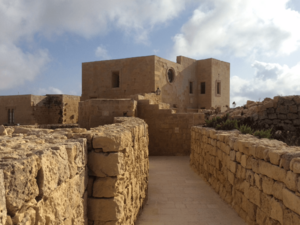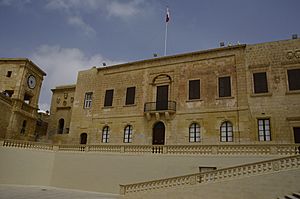Cittadella (Gozo) facts for kids
Quick facts for kids Cittadella |
|
|---|---|
| Iċ-Ċittadella | |
| Victoria, Gozo, Malta | |
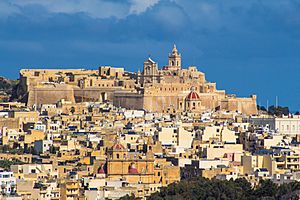
View of the Cittadella from the south
|
|
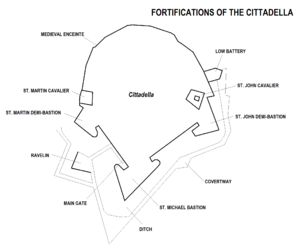
Map of the Cittadella
|
|
| Coordinates | 36°2′47″N 14°14′22″E / 36.04639°N 14.23944°E |
| Type | Citadel |
| Site information | |
| Owner | Government of Malta Various private owners |
| Open to the public |
Yes |
| Condition | Intact |
| Site history | |
| Built | c. 1500 BC (first fortifications) 15th century – 1622 (present fortifications) |
| Built by | Crown of Aragon Order of Saint John |
| In use | c. 1500 BC – 1868 |
| Materials | Limestone |
| Battles/wars | Invasion of Gozo (1551) French invasion of Malta (1798) Gozitan uprising (1798) |
| Garrison information | |
| Past commanders |
Gelatian de Sessa (attack of 1551) |
The Cittadella (which means "The Citadel" in Maltese) is a very old, fortified city on the island of Gozo, Malta. It's also known as the Castello, meaning "The Castle". This amazing place is found in Victoria, the main town on Gozo.
People have lived in this area since the Bronze Age, thousands of years ago! The Cittadella was once the high part, or acropolis, of an ancient Roman city called Gaulos.
During the Middle Ages, the Cittadella became a strong castle. It was a safe place where the people of Gozo could hide when enemies attacked. By the 1400s, a town started to grow outside its walls. This area is now the historic center of Victoria.
In the 1500s, the castle's defenses were old and not very strong. In 1551, a large army from the Ottoman Empire attacked Gozo and looted the Cittadella. This event showed how much the defenses needed to be updated.
So, between 1599 and 1622, the southern walls of the Cittadella were rebuilt. They were made much stronger, like a modern fortress. The northern walls, however, stayed mostly in their medieval style. Even after this, some people thought the new defenses weren't good enough. There were even plans to knock down the whole citadel in the 1600s and 1700s, but luckily, this never happened.
The Cittadella was briefly involved in battles during the French invasion of Malta in 1798. It surrendered quite quickly both times. It was used by the military until April 1, 1868, when the British stopped using it as a fortress.
Today, the Cittadella has churches and other historic buildings, like the Cathedral of the Assumption. This cathedral was built between 1697 and 1711. Since 1998, the Cittadella has been on Malta's list of possible UNESCO World Heritage Sites.
Contents
History of the Cittadella
Ancient Times
Even though we don't have much proof from the very beginning, it's likely that people lived in the Cittadella area since the Stone Age. This is because it's a great spot, high up and easy to defend. Pottery found here shows that it was definitely a settlement during the Bronze Age. Old storage pits for grain were found outside the Cittadella, suggesting the settlement was bigger back then.
The Victoria area stayed the main settlement on Gozo during the Phoenician and Roman times. It was known as Gaulos. The city had a high fortress (an acropolis) where the Cittadella is now, and a walled town nearby. It's believed that a temple to the goddess Juno once stood where the cathedral is today. We've found some old writings and pieces of buildings from Gaulos. One important piece is a Latin inscription from the 2nd century AD, which was reused in the Cittadella's main gate.
Parts of old walls that might have been from the Roman city's defenses have been found. In 1969, strong wall traces were found near the Main Gate. More remains were found in 2017 during an archaeological dig.
Medieval Period
During the Middle Ages, the Roman town was left behind, and the high fortress became a castle. The first time the castle of Gozo was mentioned was in 1241. It was attacked and looted in 1274. At that time, about one-third of Gozo's people lived in or near the Cittadella. Everyone on the island had to spend the night inside the castle for safety. By the late 1200s, important people from Sicily lived there. The Cittadella was called terra (land) by the mid-1300s.
Over time, the Cittadella became too small for the growing population. By the 1400s, a new town called Rabat started to grow outside the castle walls. This new settlement had its own wall with three gates. At this time, Malta and Gozo were ruled by the Crown of Aragon. The Cittadella's defenses were made stronger. The oldest parts of the walls we see today are from this period.
Rule by the Knights
In 1530, Emperor Charles V gave Malta and Gozo to the Order of St. John. The Knights were often at war with the Ottoman Empire. The Cittadella was still a medieval castle then. It offered safety to the Gozitans during attacks by the Ottomans or pirates. The biggest attack happened in July 1551. A large Ottoman force attacked Gozo and surrounded the Cittadella. The castle fell in a few days. It was looted, and most of the 6,000 Gozitans who had taken shelter there were captured. The attack left the castle in ruins. It was rebuilt soon after, but not made much more modern at first.
The Cittadella was not damaged during the Great Siege of Malta in 1565. Even though some thought about knocking down the castle, it was very important during the siege. It helped keep communication open between the besieged city of Birgu and Christian ships. After the siege, the Knights thought about making the Cittadella more modern, but they were busy building their new capital city, Valletta, on mainland Malta. Pirates attacked the Cittadella again in 1583.
In 1599, a big rebuilding project started for the Cittadella. The southern walls were completely rebuilt. They became a strong, modern fortress with a large bastion and two smaller ones, connected by walls. It also had two high platforms for cannons (called cavaliers), a ditch, and outer defenses. Parts of the northern walls were also rebuilt by the Knights, but they kept their medieval look. The walls around the town of Rabat were probably taken down at this time. The rebuilding was finished around 1622.
People on Gozo had to stay inside the Cittadella walls from sunset to sunrise until this rule was lifted in 1637. The castle was the only safe place from attacks for the island's people until Fort Chambray was built in the mid-1700s.
Even after the rebuilding, some people still thought the Cittadella's defenses were not strong enough. There were plans to destroy it and build a new fortress elsewhere. Tunnels were even built under the bastions to blow them up if needed, but it never happened.
French and British Rule
On June 10, 1798, the French army invaded the Maltese Islands. French troops landed and marched to the Cittadella. The fortress held out for a while, but it fell to the French by nightfall. This was followed by French military rule. However, after three months, the people of Malta rebelled. The Gozitans rebelled on September 3. The French soldiers in the Cittadella surrendered on October 28. The next day, the British gave control of the Cittadella to the Gozitans. They set up their own government for a short time.
When the Gozo Aqueduct was built between 1839 and 1843, a water tank was made in the Cittadella's ditch. A monument was also built near it. A road leading to the Cittadella was built in 1854, making it easier to get to the fortified city. The Cittadella stopped being a military fortress on April 1, 1868. During World War II, air raid shelters were dug under the Cittadella's bastions.
Recent History
The Cittadella's old walls are still mostly in good shape. The southern part, where the cathedral is, looks good. However, many buildings in the northern part are in ruins. Most of these ruins are from the medieval period and hold important archaeological finds. Since 1998, the Cittadella has been on Malta's list of places that could become UNESCO World Heritage Sites.
In 2006, plans were made to restore the Cittadella. This was part of a bigger project to restore other old forts in Malta. The Cittadella's restoration had two main parts. The first part, starting in 2008, was about making the walls and the ground beneath them stable. This cost about €7 million.
The second part, from 2014 to 2016, cost €14 million. The outside of the main buildings were repaired. Old ruins were cleaned and made safe. The main square and streets were paved. The ditch around the fortress was turned into a nice area for people to relax. A new door was put in a gap in the walls. The old water tank in the ditch was made into the Cittadella Visitors' Centre. The restored Cittadella was officially opened on June 30, 2016. The Visitors' Centre has won many awards.
During the restoration, many old building parts and archaeological finds were uncovered. A small, mysterious structure was found in Cathedral Square in 2014. Old Bronze Age grain pits were also found again. Parts of the Knights' fortifications that had been hidden by British changes in the 1800s were also rediscovered. These included an old entrance with a drawbridge and a secret exit. These discoveries were included in the final design of the project.
Architecture of the Cittadella
The Cittadella is built on a high point, like a small mountain, overlooking the city of Victoria. This spot was chosen because it's naturally easy to defend. It also gives great views of the surrounding countryside and much of the coastline.
Fortifications (Walls and Defenses)
The Cittadella's defenses have two main parts. The northern side has a curved wall that follows the edge of the natural hill. These walls were hard to attack. They were first built in the 1400s, but parts were rebuilt later by the Knights or in modern times. The northern walls still have parts of an old medieval tower, a blocked-up secret exit, and old lookout spots. Stone walls are built into the cliff face below the northern walls to support them.
The southern side of the city has strong, modern walls built by the Knights in the 1600s. A large, arrowhead-shaped bastion called St. Michael's Bastion is at the very south. Two smaller, half-bastions, St. Martin's and St. John's, are at the west and east ends. Small, round lookout towers are on the corners of these half-bastions. St. Michael's Bastion also had one, but it was replaced by a clock tower in 1858. A small building for storing gunpowder is where St. John's Demi-Bastion meets the old medieval wall.
These strong bastions are connected by long walls called curtain walls. The wall between St. Martin's Demi-Bastion and St. Michael's Bastion has the Main Gate. This gate has a modern arch and a clock tower. The wall between St. Michael's Bastion and St. John's Demi-Bastion is called St. Philip's Curtain. Its upper part has narrow openings that lead to a series of rooms, now used as craft shops. These rooms support a walkway along the top of the walls.
High platforms for cannons, called cavaliers, were also built near each half-bastion. St. Martin's Cavalier is partly ruined. St. John's Cavalier, near St. John's Demi-Bastion and the back of the cathedral, was finished in 1614. A separate room was built on its roof in 1701 to store gunpowder.
A five-sided gun platform called the Low Battery is built below the walls on the eastern side, near St. John's Demi-Bastion. The southern part of the Cittadella is surrounded by a ditch. This ditch originally went all the way around but now starts at St. Michael's Bastion due to changes in the 1800s. A hidden path runs along the ditch. A steep, open slope was outside this path, but it has been built over. A small, triangular outwork near the entrance has been turned into a garden.
Churches inside the Cittadella
One of the most important buildings in the Cittadella is the Cathedral of the Assumption. This is the main church for the Roman Catholic Diocese of Gozo. People believe it stands where a Roman temple to the goddess Juno once was. This temple was later changed into a Christian church. The cathedral was probably destroyed when the Maltese islands were taken over by the Arabs. A second church was built in the Middle Ages. This church was damaged in the 1551 attack but repaired. It was then damaged again in an earthquake in 1693.
The current cathedral is a beautiful Baroque building. It was built between 1697 and 1711. It was designed by Lorenzo Gafà, a famous Maltese architect. During its construction, many remains of the old Roman temple were found. The church became a cathedral in 1864. Today, it's famous for a clever painting on its ceiling. It looks like the inside of a dome, but there is no actual dome! This amazing painting was done by the Sicilian artist Antonio Manuele. A small building behind the cathedral holds the Cathedral Museum.
Two smaller chapels are also found inside the Cittadella. The Chapel of St. Joseph was first built around the 11th century. The building we see today was built in 1625.
The other chapel is dedicated to Saint Barbara. It was built in the early 1600s. This chapel is connected to the cathedral.
Other Buildings
The main square of the Cittadella is called Pjazza tal-Katidral (Cathedral Square). Here you'll find the Law Courts. These are in two buildings. One was built especially as a courthouse. The other used to be the palace of the Governor and was built in the early 1600s. Across from the Governor's Palace is the Bishop's Palace. Next to the Chapel of St. Joseph, there's a palace built by Bishop Baldassare Cagliares in 1620. A fountain against a wall remembers the naming of the city as Victoria in 1887, after Queen Victoria of Great Britain.
The following buildings are now open to the public as museums:
- The Old Prison: This prison was used from the 1500s until 1962. It has well-preserved prison cells and other exhibits.
- The Gozo Nature Museum: This museum teaches about Gozo's geography, geology, and natural science. It's in a group of 17th-century houses.
- The Gozo Museum of Archaeology: This museum focuses on Gozitan history from ancient times to the medieval period. It's located in a 17th-century house.
- Gran Castello Historic House: This museum is about Gozitan folklore and traditions. It's in a group of houses from the early 1500s.
These four museums are managed by Heritage Malta.
Images for kids
See also
 In Spanish: La Ciudadela (Gozo) para niños
In Spanish: La Ciudadela (Gozo) para niños



